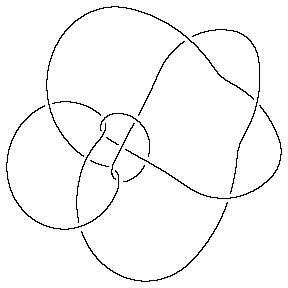Next: 4 Presentations Up: The Mathematica Package KnotTheory` Previous: 2 Setup Contents Index
![]()
![]()
![]()
![]()
![]()
Next: 4 Presentations
Up: The Mathematica Package KnotTheory`
Previous: 2 Setup
Contents
Index
KnotTheory` comes loaded with some knot tables; currently, the Rolfsen table of prime knots with up to 10 crossings [Ro], the Hoste-Thistlethwaite tables of prime knots with up to 16 crossings and the Thistlethwaite table of prime links with up to 11 crossings (Section 10.2):
|
In[2]:= ?Knot
In[3]:= ?Link
|
![\begin{figure}\centering {
\includegraphics[height=2cm]{figs/6.1.eps}
\qquad\i...
...{figs/9.46.eps}
\qquad\includegraphics[height=2cm]{figs/L6a4.ps}
}
\end{figure}](img10.gif) |
Thus, for example, let us verify that the knots
![]() and
and
![]() have the same Alexander
polynomial:
have the same Alexander
polynomial:
In[4]:= | Alexander[Knot[6, 1]][t] |
Out[4]= | 2
5 - - - 2 t
t |
In[5]:= | Alexander[Knot[9, 46]][t] |
Out[5]= | 2
5 - - - 2 t
t |
We can also check that the Borromean rings, L6a4 in the Thistlethwaite table, is a 3-component link:
In[6]:= | Length[Skeleton[Link[6, Alternating, 4]]] |
Out[6]= | 3 |
|
In[7]:= ?AllKnots
In[8]:= ?AllLinks
|
Thus at the moment there are 802 knots and 1424 links known to KnotTheory`:
In[9]:= | Length /@ {AllKnots[], AllLinks[]} |
Out[9]= | {802, 1424} |
Note though that if you have also loaded the further files DTCodes4Knots12To16.tar.gz (8252Kb) or DTCodes4Knots12To16.zip (8244Kb), the contents of AllKnots[] does not change but higher knots in the Hoste-Thistlethwaite enumeration become available:
In[10]:= | Show[DrawPD[Knot[13, NonAlternating, 5016], {Gap -> 0.025}]] |
 | |
Out[10]= | -Graphics- |
(Shumakovitch had noticed that this nice knot has interesting Khovanov homology; see [Sh, Section A.4]).
In addition to the tables, KnotTheory` also knows about torus knots:
|
In[11]:= ?TorusKnot
|
For example, the torus knots T(5,3) and
T(3,5) have different presentations with different numbers of crossings,
but they are in fact isotopic, and hence they have the same invariants
(and in particular the same type 3 Vassiliev invariant ![]() ):
):
In[12]:= | Crossings /@ {TorusKnot[5,3], TorusKnot[3, 5]} |
Out[12]= | {10, 12} |
In[13]:= | Vassiliev[3] /@ {TorusKnot[5,3], TorusKnot[3, 5]} |
Out[13]= | {20, 20} |
KnotTheory` knows how to plot torus knots; see Section 8.1.